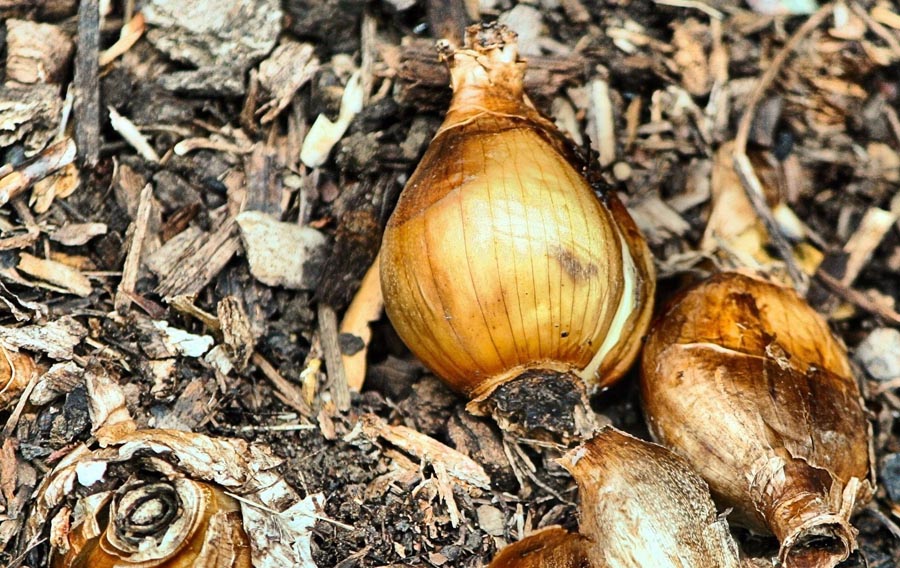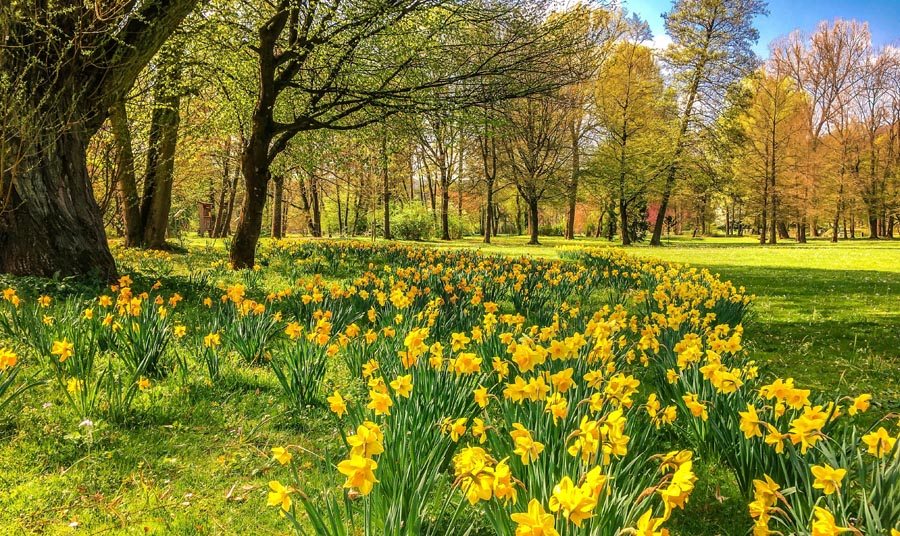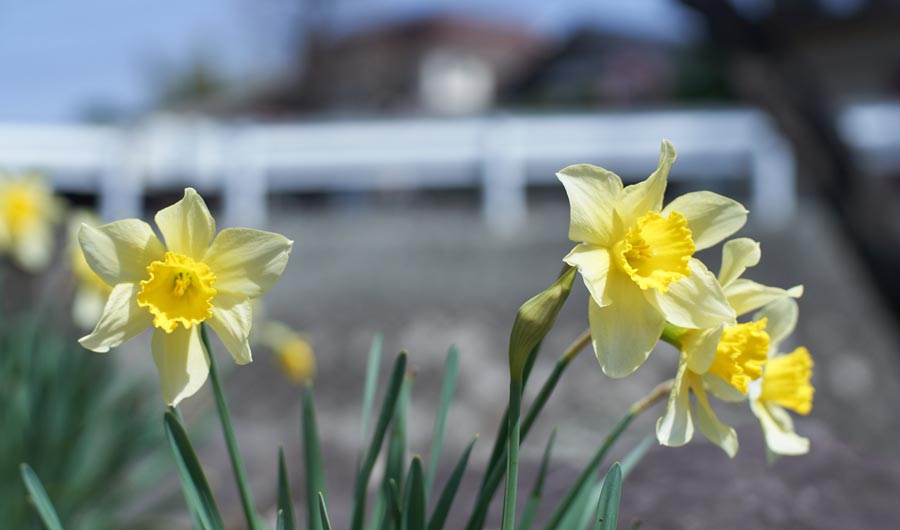
If you are asking yourself “why are my daffodil leaves turning yellow?”, you probably aren’t the only one.
If the foliage of your daffodil begins to turn yellow immediately before or during bloom time, or at the height of the growing season there is most probably something wrong.
It might not be anything serious, but even if it is, then knowing what is wrong means you can prevent it from reoccurring in the future.
So let’s dive in and explore what might be causing your daffodil leaves to turn yellow.
Why Are My Daffodil Leaves Turning Yellow?
The reasons for your daffodil’s leaves turning yellow could be down to a range of factors. Often a fungal disease is the cause and, unfortunately in such cases, there is no cure and the bulbs will need to be removed. But it could also be down to something as simple as poor soil or lack of sunlight, which is much easier to rectify.
Reason #1: It Could Be Basal Rot
Basal rot is a fungal infection that lies dormant in the soil and becomes active when temperatures reach around 55°F (12°C).
One of the first signs of basal rot is leaf yellowing.
Once infected with basal rot daffodil bulbs cannot be saved.
However, there are ways to determine if a daffodil bulb may be suffering from basal rot before you plant it.
If a bulb seems dried up or decayed, is softer than would be expected, or bears a pinkish-white fungus do not plant it as it could be suffering from basal rot, instead dispose of it safely.
If your bulb is already planted, yellowing leaves are the first sign of basal rot usually followed by a dark purple discoloration appearing at the base of your daffodil and rising upwards.
You should dig up these bulbs as soon as possible, dispose of them and treat the surrounding soil with fungicide to limit the likelihood of the basal rot spreading to your healthy daffodil bulbs.
Reason #2: It Could Be Leaf Scorch

If you notice your daffodil leaves turning yellow on the edges and the tips displaying yellow or reddish-brown lesions the leaf scorch could be at play.
Leaf scorch is another fungal disease that lives on the necks and foliage of daffodils and is most prominent in mild and moist summer weather.
If left untreated the lesions on the leaves can merge, causing them to turn brown and die.
RELATED ===> What Could Be Eating My Daffodils?
If caught early your first course of action should be to cut away the affected parts with a sharp, sterilized blade.
If the disease has spread you will need to dig up the affected bulbs and dispose of them, making sure not to put them in your compost pile if you have one.
As with basal rot, you will want to treat the affected soil with fungicide. Also, rake away any leaves and plant debris in the area around the plant and dispose of it safely.
To minimize the chance of leaf scorch recurring in the future you should try and rotate your beds for at least three years.
Do this by lifting healthy bulbs in the summer after the leaves have died back, storing them safely and then planting in a different bed in the fall.
The fungal pathogen that causes leaf scorch can also spread through soil and on garden tools as well.
So to be extra vigilant sanitize your garden tools with bleach and water and you might also want to sanitize any shoes you wear in the garden to avoid accidentally treading contaminated soil into other areas of your garden.
Reason #3: It Could Be Yellow Stripe Virus
Yellow stripe virus is what is known as a mosaic virus, which causes infected foliage of a plant to have a mottled appearance.
Such viruses usually manifest themselves with yellow or green streaks, stripes or splotches appearing on the upper daffodil leaves soon after they emerge.
Infected leaves might also be distorted, appearing bent or twisted.
There is no known cure for yellow stripe virus or any mosaic virus. You must dig up your bulb and discard it.
To prevent it reoccuring let the ground lie fallow for a year and be aware of pests such as nematodes and aphids which can spread the disease.
Reason #4: It Could Be Root Rot
Root rot is another fungal disease that can cause leaves to look yellow, withered or stunted.
It is most common in established bulbs that have been planted for several years.
More often than not it is caused either by overwatering to the extent the soil is perpetually wet (or it doesn’t drain well), or bulbs being planted too deeply.
If identified early then root rot should not be deadly.
If the soil is wet then either reduce the frequency with which you water, or move the daffodils to an area with improved drainage.
You will also want to apply a fungicidal treatment to the soil to prevent root rot from returning in future seasons.
RELATED ===> Why Do Daffodils Bend Over?
Reason #5: It Could Be Down to a Lack of Sunlight

Daffodils need around six hours of sun a day to bloom properly and will grow in full sun or light shade.
If they are planted in full shade however the lack of sunlight could cause the yellowing of their leaves.
If you think your daffodils aren’t getting enough sunshine try digging them up and replanting in a sunnier area.
Reason #6: It Might Be Too Hot
Daffodils like a lot of sun and are hardy enough to deal with warm temperatures, but if it is too hot over a prolonged period of time it can cause their leaves to turn yellow and dry out.
If you live in an area that has very warm summers, try planting your daffodils in a spot with light shade where it gets some protection from the sun.
If you have them in a vase indoors, keep them near a window for bright but filtered light and try and make sure they are in a cool room with a temperature of about 60°F.
Reason #7: They Might Not Be Getting Enough Nutrients From the Soil
One of the telltale signs of nutrient deficiency in any plant is the yellowing of its leaves.
Generally, it is less likely in daffodils and any other plant grown from bulbs that store nutrients, but it isn’t unheard of.
One of the key contributors to this is overcrowding, with too many bulbs in the same area competing for limited water and nutrients in the soil.
A good way to ensure this doesn’t happen is to divide and replant your daffodil bulbs every five years as they multiply.
You can also get your soil tested to identify any possible nutrient deficiencies.
Reason #8: It Could Be Down to Too Much Fertilizer

If you have read through reasons 1 to 7 above, and don’t believe the cause of your daffodil leaves turning yellow is any of them, then they might benefit from a dose of fertilizer.
But, do not excessively fertilize your daffodil as it will result it new leaves growing thick and uneven, and old leaves drying out and yellowing.
RELATED ===> How To Get Rid Of Daffodils In Your Lawn
Reason #9: It Could Be Because Your Daffodil is Reaching Maturity
After your daffodil has bloomed it is natural for the leaves to gradually turn yellow.
The foliage will usually stay green for several weeks, then around the six-week mark begin to turn yellow and wither.
Up until that point the green leaves have been doing their job, by conducting photosynthesis and sending the energy back to the bulb.
When they have done their job for the season you should let the leaves turn yellow and then brown, then you should easily be able to remove the dead foliage.
Final Thoughts
Let me just reiterate that last reason, if your daffodil has finished blooming before you see any yellowing occur, then you have absolutely nothing to worry about.
It is just part of a healthy daffodil’s life cycle.
It is when yellowing occurs at other times that you should take action.
Often the culprit is a fungal disease, and unfortunately many of these cannot be cured.
However, knowing the signs to look out for can help you prevent them in the future.
If it isn’t a fungal disease then it is likely something to do with your daffodil’s growing conditions. This is much easier to rectify.
